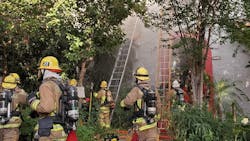The Glendale Fire Department has released its after actions report following a difficult January apartment building fire that resulted in injuries to two firefighters who fell through a collapsed floor into the basement.
On Jan. 16, Glendale crews responded to a fire call at 140 Carr Drive at around 2:48 p.m. and found smoke showing on the initial size-up and then assessed that victims were trapped on the second floor of the structure.
The fire was in a fully developed stage at this point in the lower portion of the building with heavy smoke on the first and second floors, but what command did not know at the time was the structure also had active fire in the basement. It wasn't until 17 minutes into the incident that firefighters realized they were conducting search and rescue ops along the first floor with active fire beneath them.
You can watch some on-scene video of the incident below:
While crews were transitioning from interior search and rescue to an exterior attack to try and mitigate the basement conditions, a firefighter became lost/separated from his company for two to three minutes, but a mayday was not initiated by any involved members and the Incident Commander was never informed of the situation.
About forty minutes after dispatch, a portion of the first floor collapsed, sending a captain and a firefighter plummeting into the basement. This triggered a quick mayday call, and a hoseline was immediately directed through the collapsed floor near the front door to protect the two crew members. The RIT was already suited up and moved to a basement entryway, where the two members were assisted in escaping.
The firefighter suffered multiple soft tissue injuries and required surgery to remove debris from his left wrist, while the captain suffered second-degree burns to both wrists. Both have fully recovered and are back on active duty.
The other good news from the incident is that all six occupants were safely rescued. Three of them were treated on scene and released, while three others were transported to a hospital with non life-threatening injuries.
The report highlights several areas for improvement or more strict adherence to established protocol, including assumption of command, situational awareness, risk assessment/management and communications.
Some of the fireground and mayday-related lessons learned are highlighted below:
Fireground Operations:
- All resources responding to an incident should consider suiting up prior to arriving on scene of any emergency, so that you are not playing catch up for immediate issues that present when you arrive on scene (i.e. Rescues/victims trapped).
- Anytime you enter the IDLH have all PPE’s donned appropriately.
- As the first arriving resource on scene, consider passing command when it is appropriate to the next arriving resource.
- No matter when you arrive on an incident, it’s the responsibility of all members to communicate matters that can affect tactical operations and safety of all members.
- Advise the IC when structural integrity of a building is compromised or a hazardous condition is present. (Working with fire below you should be the exception and not the rule, but if you have to work with fire below you, at a minimum, sound the floor with the same discipline of sounding a roof.)
- Companies and personnel should have a contingency plan for communications if they have an important message such as a lost/separated firefighter and they can’t get out on the incident Tactical channel. (i.e. Etrigger or another channel monitored by the IC).
Mayday:
- As the IC, consider having a mnemonic on your tactical worksheet to assist you during “Mayday” operations.
- Don’t hesitate to call a “Mayday” for yourself or another member on scene when a firefighter emergency exists (i.e. firefighter missing, down or trapped.)
- When calling a “Mayday,” reports should include company number(s) and rank/position if known, as well as location and needs. (Not names)
- The radio E-trigger can be utilized if you can’t get through on TAC/Command channel in a timely manner.
- Have a plan for the IC or Staff Captain/Aide to maintain communications with the downed, missing or trapped FF or the person calling the “Mayday.”
- Make sure to request additional resources from the Dispatch Center or Staging if adequate resources are already on scene.
- Critical Incident Stress Management (CISM) should be offered to all members on scene. If members decline, consideration should still be given to require that members attend.
You can read the full 30-page report here, and watch the detailed video below for a full review of the incident.






